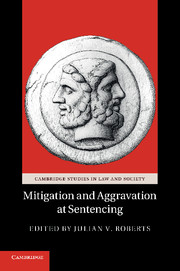Book contents
- Frontmatter
- Contents
- Tables
- Contributors
- Foreword
- Acknowledgments
- Chapter one Punishing, more or less
- Chapter two Re-Evaluating the Justifications for Aggravation and Mitigation at Sentencing
- Chapter three The Search for Principles of Mitigation
- Chapter Four Personal Mitigation and Assumptions about Offending and Desistance
- Chapter Five Intoxication as a sentencing factor
- Chapter Six Beyond the Partial Excuse
- Chapter Seven Equality before the law
- Chapter Eight Personal mitigation
- Chapter Nine Exploring Public Attitudes to Sentencing Factors in England and Wales
- Chapter Ten The Pernicious Impact of Perceived Public Opinion on Sentencing
- Chapter Eleven Addressing Problematic Sentencing Factors in the Development of Guidelines
- Chapter Twelve Proof of Aggravating and Mitigating Facts at Sentencing
- Chapter Thirteen Mitigation in Federal Sentencing in the United States
- Chapter Fourteen The discretionary effect of mitigating and aggravating factors
- Index
- References
Foreword
Published online by Cambridge University Press: 07 September 2011
- Frontmatter
- Contents
- Tables
- Contributors
- Foreword
- Acknowledgments
- Chapter one Punishing, more or less
- Chapter two Re-Evaluating the Justifications for Aggravation and Mitigation at Sentencing
- Chapter three The Search for Principles of Mitigation
- Chapter Four Personal Mitigation and Assumptions about Offending and Desistance
- Chapter Five Intoxication as a sentencing factor
- Chapter Six Beyond the Partial Excuse
- Chapter Seven Equality before the law
- Chapter Eight Personal mitigation
- Chapter Nine Exploring Public Attitudes to Sentencing Factors in England and Wales
- Chapter Ten The Pernicious Impact of Perceived Public Opinion on Sentencing
- Chapter Eleven Addressing Problematic Sentencing Factors in the Development of Guidelines
- Chapter Twelve Proof of Aggravating and Mitigating Facts at Sentencing
- Chapter Thirteen Mitigation in Federal Sentencing in the United States
- Chapter Fourteen The discretionary effect of mitigating and aggravating factors
- Index
- References
Summary
Explicit guidance for sentencing decisions, and an explicit rationale to guide them, has been a notable feature of sentence-reform efforts over recent decades. In England and Wales a system of sentencing guidelines is in place, based on statutory standards and guidelines provided by the Sentencing Council. Meanwhile, an extensive literature on sentencing theory has developed – for example, that based on notions of desert and proportionate sanctions, or on notions of ‘limiting retributivism’ (von Hirsch and Ashworth 2005: ch. 9 and appendix 2).
Yet, curiously, little attention has been paid to aggravating and mitigating circumstances affecting the sentence. The first systematic effort at sentencing guidance in England and Wales, the Criminal Justice Act 1991, established a system of statutory guiding principles; these norms were aimed at helping to establish gradations of sentence for various crimes, based chiefly on offence-seriousness. However, the legislation omitted any guidance on aggravating or mitigating circumstances affecting sentence. It was only a decade and a half later, in 2004, that the Sentencing Guidelines Council (since replaced by the Sentencing Council of England and Wales) adopted a list of aggravating and mitigating factors. Sentencing theorists and scholars have, if anything, been still more neglectful of the subject; this is the first major book devoted to the topic.
- Type
- Chapter
- Information
- Mitigation and Aggravation at Sentencing , pp. xiii - xviPublisher: Cambridge University PressPrint publication year: 2011
References
- 2
- Cited by

